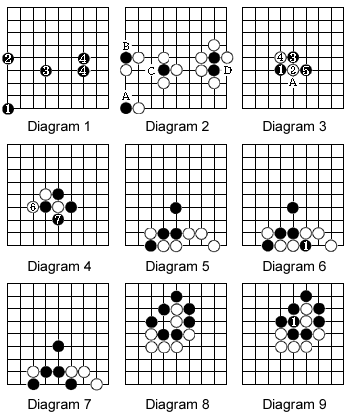How to teach go
One of the problems that a Western go player faces is that so few people play this game outside of the Orient. Just the size of the board often scares people away because it gives the impression that it is a difficult game to learn. Therefore, if you want your friends to learn and become addicted to go, this impression must be erased. The way to do this is to teach them on a 9 x 9 board instead of the standard 19 x 19 one, and to introduce the concepts in a clear logical order.This method has been promoted by Yasutoshi Yasuda, 9-dan of the Japan Go Association. Yasuda travels around the country teaching go at schools, ranging from kindergartens to universities, as well as hospitals and homes for the elderly. He believes go stimulates analytical as well as creative thinking and promotes social harmony by improving communication among people. As one of his assistants, I have been fortunate to see him in action. Accompanied by his crew of assistants, he enters a school or another location with 9 x 9 boards and sits down. People start approaching, first hesitantly, but after one hour 20 new students ranging in age from 5 to 80 begun to learn the game. A truly enrapturing experience. Here is his method.
Stage 1: The Capturing Game
- Always start on a 9 x 9 board.
- Next, show that stones may be played only on the intersections, which include the points on the edge and the corner points. Then explain what a "liiberty" is. For example, in Diagram 1, the stone at 1 has two liberties at adjacent intersections, the stone at 2 has three liberties, the stone at 3 has four liberties and the group of two stones at 4 has six liberties.
Now you can demonstrate how to capture a stone by taking away its liberties one by one and finally taking the stone off the board by occupying its last liberty. Diagram 2 shows the black stones in Diagram 1 with all of their liberties but one occupied by white. If White plays A, he captures the black stone on the corner point; if White plays B, he captures the black stone on the edge; if he plays C, he captures the black stone in the center; and, if he plays D, he captures the black two-stone group.
- You can show a few more small groups and how to capture them. But, for the time being, don't use any advanced concepts such as "eyes,""living group," or "territory." Diagram 3 shows an example of a game between two beginners. After Black 5, the white stone at 2 has only one liberty remaining. Therefore, he should extend to A to avoid being captured. In Diagram 4, White foolhardily keeps attacking with 6, so Black is able to capture the white stone with 7.
In Diagram 5, it is Black's turn to play, and he can capture two white stones. by playing at 1 (Diagram 6). The position after the two stones have been taken off the board is shown in Diagram 7. In Diagram 8, Black is to play and capture two white stones. Black 1 accomplishes this (Diagram 9).
- Now your students can start playing the first stage of go: "the capturing game." In this game, the first to capture one stone or more wins the game.
If you are an experienced player you may be skeptical about this method, but it is amazing how much the students learn by themselves when they play with other beginners. Moreover, it is really fun! Instantaneous gratification, without a lot of hard work!
Stage 2: Capturing three stones
After the students have played the capturing game a lot, their games tend to end in a draw (with no stones captured). Now is the time to introduce them to Stage 2: The first person who captures three stones wins. Sometimes this means three stones at once but more often it will be a gradual process with stones being captured one by one. At this stage, ko may happen for the first time (there is no ko when the first one to capture anything wins). When the first ko occurs it is good if the teacher is around. Do not show it to the students in advance; just wait until it happens.
Stage 3: Counting Territory
The wonderful thing about this method is that after the students have played "capture three" for a while, they begin to make groups with two eyes by themselves. And soon after that, their games will again start ending in draws. They are now ready for the next stage to decide who wins: counting the territory. Now they are playing real go, basically self-taught--without pain, without confusion, without feeling stupid or thinking too hard.
Next week, ko will be discussed and some basic life and death problems will be illustrated.
A go course for beginners in English is being given at Ben's Cafe in Takadanobaba, Tokyo, (Tel. 03-3202-2445) every Sunday from 11 a.m. to 1 p.m. The lessons are free for beginners (Japanese included), so come and join the fun!

